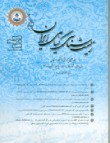Investigating the Effect of Different Ultraviolet (UV) Radiation Bands on Oxidative Stress Induction and Resistance Mechanisms in Lemon Balm (Melissa officinalis) Seedlings
The destruction of the ozone layer leads to the penetration of some harmful solar radiation, such as ultraviolet rays into the atmosphere. These radiations have negative effects on plants’ growth and development. The current study investigated the effect of three UV radiation bands on plant growth, oxidative stress induction, and defense mechanisms in Melissa officinalis seedlings. The experiment was conducted in a hydroponics system under a completely randomized plan with three replicates. The seedlings, after a seven-leaf stage, were exposed to UV-A and UV-B for 20 min, and UV-C for three min daily for one week. The effect of different UV bonds was reported on oxidants, such as oxygen free radicals (ROS), hydrogen peroxide (H2O2), malondialdehyde (MDA), antioxidants (total antioxidants, phenolic compounds, anthocyanin and superoxide dismutase (SOD) enzyme activity), and seedling growth. The results revealed that UV-A radiation did not induce a significant effect on ROS, H2O2 and MDA contents compared with those of the control. However, under UV-B and UV-C ROS, H2O2 and MDA contents showed 59-89, 67-104, and 103-166 % increase compared with the control. All of the studied anti-oxidant content increased under three different UV radiations. The highest increase was reported for phenolic compounds with 148-178% compared with the control. The oxidant content increased under UV-B, and UV-C indicating that the plants’ anti-oxidant system was unable to sweep ROS and reduce the stress. Consequently, the radiation treatments reduced root and shoot fresh weight. Overall, the results indicated that the lemon balm plant was sensitive to UV radiation.
Plants need light for photosynthesis and respond to light through different photoreceptors. Apart from active photosynthetic rays (PAR), plants are also exposed to other rays including ultraviolet (UV) light. Ultraviolet rays are classified based on their wavelengths into UV-C (200-280 nm), UV-B (280-320 nm), and UV-A (320-390 nm). UV-C is the most dangerous range of ultraviolet light that is completely absorbed by the ozone layer. UV-B is very important because of its severe destructive effects on the growth and development of plants. UV-A radiation has less toxic effects than other wavelengths of ultraviolet radiation. Plants control growth and development changes in response to UV by creating a complex network of transcriptomes. Severe UV-B or UV-C stress leads to cell cycle arrest, chloroplast and mitochondrial dysfunction, DNA fragmentation, and finally programmed cell death (PCD). The amount of damage in plants varies depending on environmental factors, plant species, intensity of radiation, and type of radiation. Current knowledge about the eco-physiological impact of UV radiation on plants is limited. In this study, the effects of UV-A, UV-B, and UV-C on growth, induction of oxidative stress and resistance mechanisms of Melissa officinalis seedlings were studied.
The seeds of Melissa officinalis were grown in containers with perlite. After germination, plants were transferred to pots containing washed perlite and irrigated with Hoagland's nutrient solution with one-fifth dilution. The lemon balm plants were exposed to ultraviolet rays (UV-A and UV-B for 20 minutes, and UV-C for 3 minutes) for one week after the 7-leaf stage. The control plants were exposed to visible light in the growth chamber. At the end of the treatments, growth parameters (fresh weight of shoots, roots, and leaves), oxidants (ROS, H2O2, and MDA), and antioxidants (total antioxidants, phenolic compounds, anthocyanins, and SOD enzyme activity) were measured. The experiment was conducted in a completely randomized design (CRD) with three replications (n=3). The analysis of variance (ANOVA) and SPSS 22 software were used for the statistical analysis of the data. Mean data were compared by Duncan's multiple range test (p ≤ 0.05).
The results of the study revealed that there is a positive correlation of 0.9 (R2) between oxidant indices, such as ROS, H2O2, and MDA in the treated plants. The amount of oxidants in seedlings treated with UV-A did not show any significant difference in comparison with the control plants. UV-B and UV-C rays increased oxidant contents. UV-B and UV-C rays lead to the transfer of electrons to O2 and the formation of active oxygen species due to the photo-oxidation of the chloroplast membrane and mitochondria. The produced ROS are highly reactive and lead to oxidative damage to DNA, proteins, and lipid peroxidation. The antioxidant system in cells was able to remove ROS molecules.
The results of the analysis of variance obtained from the data showed that all the antioxidant indices measured in this study increased in all of the seedlings treated with UV. The increase of these organic compounds in plants was probably due to the induction effect of UV rays on the genes encoding the enzymes of relevant pathways. However, UV-B and UV-C rays led to an increase in the amount of ROS, increased lipid peroxidation, and ultimately cell damage, despite the increase in non-enzymatic and enzymatic antioxidant system components. This system was not able to control 100% of the effects caused by these rays in plants. Therefore, it led to the reduction of biomass in UV treatments, which was a general response in many plant species under severe stress conditions.
Considering the result of the present study, Melissa officinalis seedlings showed physiological changes when exposed to ultraviolet rays. Increasing the amount of antioxidants in UV treatments allowed plants to survive under oxidative stress conditions, but it still caused damage (e.g. oxidants increase and weight decrease) to the plant. Therefore, Melissa officinalis was sensitive to stress caused by ultraviolet rays.
- حق عضویت دریافتی صرف حمایت از نشریات عضو و نگهداری، تکمیل و توسعه مگیران میشود.
- پرداخت حق اشتراک و دانلود مقالات اجازه بازنشر آن در سایر رسانههای چاپی و دیجیتال را به کاربر نمیدهد.



